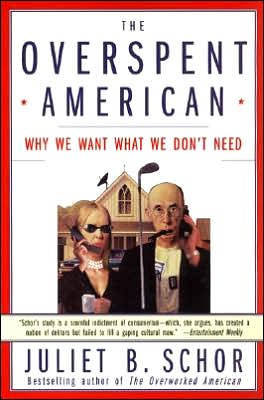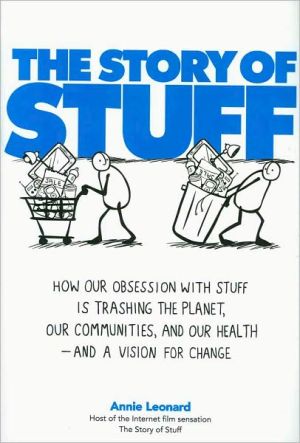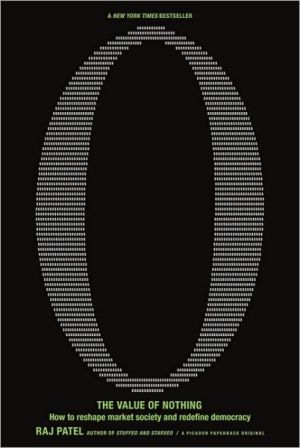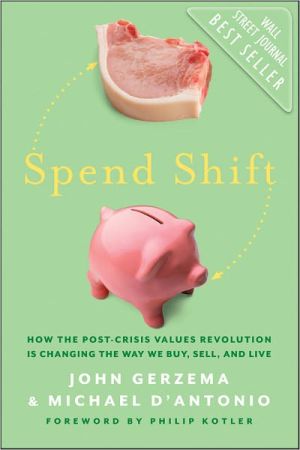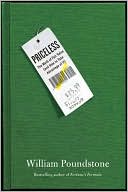Overspent American: Why We Want What We Don?t Need
The Overspent American explores why so many of us feel materially dissatisfied, why we work staggeringly long hours and yet walk around with ever-present mental "wish lists" of things to buy or get, and why Americans save less than virtually anyone in the world. Unlike many experts, Harvard economist Juliet B. Schor does not blame consumers' lack of self-discipline. Nor does she blame advertisers. Instead she analyzes the crisis of the American consumer in a culture where spending has become...
Search in google:
The Overspent American explores why so many of us feel materially dissatisfied, why we work staggeringly long hours and yet walk around with ever-present mental "wish lists" of things to buy or get, and why Americans save less than virtually anyone in the world. Unlike many experts, Harvard economist Juliet B. Schor does not blame consumers' lack of self-discipline. Nor does she blame advertisers. Instead she analyzes the crisis of the American consumer in a culture where spending has become the ultimate social art. Peter T. Kilborn Schor's message and her inviting command of the language will strike a chord among many debt-laden middle-class readers. Her notion of reference-group competition, rooted in impressive polling and rigorous analysis, is an original contribution to understanding why people are so readily seduced by the temptation to buy. — New York Times Book Review
\ Chapter One\ \ In 1996 a best-selling book entitled The Millionaire Next Door caused a minor sensation. In contrast to the popular perception of millionaire lifestyles, this book reveals that most millionaires live frugal lives-buying used cars, purchasing their suits at JC Penney, and shopping for bargains. These very wealthy people feel no need to let the world know they can afford to live much better than their neighbors.\ Millions of other Americans, on the other hand, have a different relationship with spending. What they acquire and own is tightly bound to their personal identity. Driving a certain type of car, wearing particular designer labels, living in a certain kind of home, and ordering the right bottle of wine create and support a particular image of themselves to present to the world.\ This is not to say that most Americans make consumer purchases solely to fool others about who they really are. It is not to say that we are a nation of crass status-seekers. Or that people who purchase more than they need are simply demonstrating a base materialism, in the sense of valuing material possessions above all else. But it is to say that, unlike the millionaires next door, who are not driven to use their wealth to create an attractive image of themselves, many of us are continually comparing our own lifestyle and possessions to those of a select group of people we respect and want to be like, people whose sense of what's important in life seems close to our own.\ This aspect of our spending is not new--competitive acquisition has long been an American institution. At the turn of the century, the rich consumed conspicuously. In the earlypost-World War 11 decades, Americans spent to keep up with the Joneses, using their possessions to make the statement that they were not failing in their careers. But in recent decades, the culture of spending has changed and intensified. In the old days, our neighbors set the standard for what we had to have. They may have earned a little more, or a little less, but their incomes and ours were in the same ballpark. Their house down the block, worth roughly the same as ours, confirmed this. Today the neighbors are no longer the focus of comparison. How could they be? We may not even know them, much less which restaurants they patronize, where they vacation, and how much they spent for their living room couch.\ For reasons that will become clear, the comparisons we make are no longer restricted to those in our own general earnings category, or even to those one rung above us on the ladder. Today a person is more likely to be making comparisons with, or choose as a "reference group," people whose incomes are three, four, or five times his or her own. The result is that millions of us have become participants in a national culture of upscale spending. I call it the new consumerism.\ Part of what's new is that lifestyle aspirations are now formed by different points of reference. For many of us, the neighborhood has been replaced by a community of coworkers, people we work alongside and colleagues in our own and related professions. And while our real-life friends still matter, they have been joined by our media "friends." (This is true both figuratively and literally-the television show Friends is a good example of an influential media referent.) We watch the way television families live, we read about the lifestyles of celebrities and other public figures we admire, and we consciously and unconsciously assimilate this information. It affects us.\ So far so good. We are in a wider world, so we like to know that we are stacking up well against a wider population group than the people on the block. No harm in that. But as new reference groups form, they are less likely to comprise people who all earn approximately the same amount of money. And therein lies the problem. When a person who earns $75,000 a year compares herself to someone earning $90,000, the comparison is sustainable. It creates some tension, even a striving to do a bit better, to be more successful in a career. But when a reference group includes people who pull down six or even seven-figure incomes, that's trouble. When poet-waiters earning $18,ooo a year, teachers earning $30,000, and editors and publishers earning six-figure incomes all aspire to be part of one urban literary referent group, which exerts pressure to drink the same brand of bottled water and wine, wear similar urban literary clothes, and appoint apartments with urban literary furniture, those at the lower economic end of the reference group find themselves in an untenable situation. Even if we choose not to emulate those who spend ostentatiously, consumer aspirations can be a serious reach.\ Advertising and the media have played an important part in stretching out reference groups vertically. When twenty-somethings can't afford much more than a utilitarian studio but think they should have a New York apartment to match the ones they see on Friends, they are setting unattainable consumption goals for themselves, with dissatisfaction as a predictable result. When the children of affluent suburban and impoverished inner-city households both want the same Tommy Hilfiger logo emblazoned on their chests and the top-of-the-line Swoosh on their feet, it's a potential disaster. One solution to these problems emerged on the talk-show circuit recently, championed by a pair of young urban "entry-level" earners: live the faux life, consuming as if you had a big bank balance. Their strategies? Use your expense account for private entertainment, date bankers, and sneak into snazzy parties without an invitation. Haven't got the wardrobe for it? No matter. Charge expensive clothes, wear them with the tags on, and return them the morning after. Apparently the upscale life is now so worth living that deception, cheating, and theft are a small price to pay for it.\ These are the more dramatic examples. Millions of us face less stark but problematic comparisons every day. People in one-earner families find themselves trying to live the lifestyle of their two-paycheck friends. Parents of modest means struggle to pay for the private schooling that others in their reference group have established as the right thing to do for their children.\ Additional problems are created by the accelerating pace of product innovation. To gain broader distribution for the plethora of new products, manufacturers have gone to lifestyle marketing, targeting their pitches of upscale items at rich and nonrich alike. Gourmet cereal, a luxurious latte, or bathroom fixtures that make a statement, the right statement, are offered to people almost everywhere on the economic spectrum. In fact, through the magic of plastic, anyone can buy designer anything, at the trendiest retail shop. Or at outlet prices. That's the new consumerism. And its siren call is hard to resist...
Acknowledgments.....................................................ixPreface...........................................................xiii 1 Introduction.....................................................1 2 Communicating with Commodities: How What We Buy Speaks 3 The Visible Lifestyle: American Symbols of Status...............43 4 When Spending Becomes You.......................................65 5 The Downshifter Next Door......................................111 6 Learning Diderot's Lesson: Stopping the Upward Creep of Epilogue: Will Consuming Less Wreck the Economy?...................169 Bibliography.......................................................175 Appendixes.........................................................197 Organizations......................................................209
\ Peter T. KilbornSchor's message and her inviting command of the language will strike a chord among many debt-laden middle-class readers. Her notion of reference-group competition, rooted in impressive polling and rigorous analysis, is an original contribution to understanding why people are so readily seduced by the temptation to buy. — New York Times Book Review\ \ \ \ \ Publishers Weekly\ - Publisher's Weekly\ Whereas Schor's 1992 bestseller, The Overworked American, touched a nerve among all classes of American society, her latest study is geared to middle- and upper-middle-class consumers who, in her diagnosis, are participating in a national orgy of overspending and living beyond their means. She traces this competitive, status-conscious consumption to the diverging income distribution and growing inequality beginning in the 1980s, as increasingly overworked, insecure, dissatisfied consumers, pressured by advertising and television imagery, sought to emulate the upscale lifestyle of the most affluent. An economist and director of women's studies at Harvard, Schor presents her arguable conclusion that the more TV a person watches, the more he or she is likely to spend. In counterbalance, she also reports on her nationwide survey of "downshifters," people who deliberately reduce their hours on the job in exchange for more leisure, time with family or other pursuits. In self-help fashion, she outlines nine steps individuals can take to break free of the cycle of compulsive spending. Although Schor's jeremiad lacks the impact of her earlier book, it offers trenchant commentary on Americans' overspending lifestyle and lack of savings.\ \ \ Library JournalThe dual purpose of this slim volume is to describe how spending, as a process, affects the quality of life for the middle and upper classes and to show how to develop a life that puts materialism and consumerism in proper perspective. Economist Schor states that in the 1950s "keeping up with the Joneses" held sway; today, however, purchases convey status and identity with our reference groups, e.g., co-workers, media stars on television, and those with similar values, not necessarily our neighbors. Schor argues that rampant advertising and consumerism is driving an unsatisfying materialist life. She also describes "downshifters," those who reduce their income and expenditures to get off the spiral of more work to acquire increasingly expensive stuff. Unfortunately, her book's strong academic foundation is undercut by weak conclusions. Schor's The Overworked American (LJ 1/92) covered much of the same ground, and libraries that found an audience for that title will be well served by this one. -- Patrick J. Brunet, Western Wisconsin Technical Coll. Lib., LaCrosse\ \ \ \ \ BooknewsExplores why so many of us feel materially dissatisfied and how "keeping up with the Jonses" has changed. The author traces America's spending problems to our class-based society and its inequalities and shows how the new consumerism hurts the public good, the environment, and the quality of life. She looks at the growing consumer backlash to escalating consumption and invites readers to examine their relationship to spending in order to break the insidious work- and-spend cycle.\ \ \ \ \ Entertainment WeeklySchor's study is a scornful indictment of consumerism -- which, she argues, has created a nation of debtors but failed to fill a gaping cultural maw.\ \ \ \ \ Kirkus ReviewsConsuming more now and enjoying it less? In this heavily researched but accessible work, Schor (Women's Studies/Harvard; The Overworked American) tells us how and why this is so and what we might do about it. "See-want-borrow-and-buy" is Schor's succinct summation of American spending habits. As status and identity become increasingly indistinguishable, our very sense of worth becomes invested in what we buy. We spend billions for status. Given identical pairs of jeans, identical tubes of lipstick, we will more than likely buy, at a much higher price, the item with the designer label. Yet, such spending is self-defeating and never-ending. We no longer wish simply to keep up with our neighbors, but to emulate the spending habits of the richest 20 percent of Americans (television is the main vehicle through which we know what they buy). As their consumption increases, then, so does ours. The result of this endless game of catch-up is Americans working more, going increasingly into debt, but finding themselves no more happy or contented, in fact often a great deal less so. Further, as we spend privately our support for collective consumptionþon education, social services, public safetyþdiminishes, further eroding our sense of well-being. Itþs possible, but not easy given how natural it seems, to get out of this cycle of self-defeating consumption. Millions of Americans, whom Schor terms "downshifters," have opted to work, earn, and consume less and in the process created richer, more meaningful lives. Schor supports all of these findings with abundant, perhaps overabundant, survey data. Missing, though, is a consideration of why consumption is so deeply ingrainedin us, whatþs lacking in our collective lives that leads to such compensatory consumption. She discusses fears of downward mobility but never really develops this theme. Despite some shortcomings, this is an important analysis of who, or perhaps what, we are. It deserves and will surely gain a wide audience.\ \
